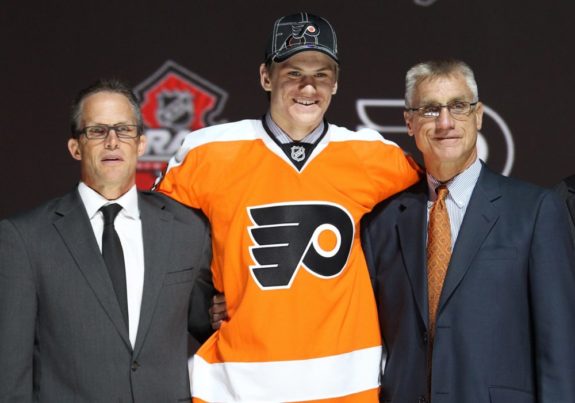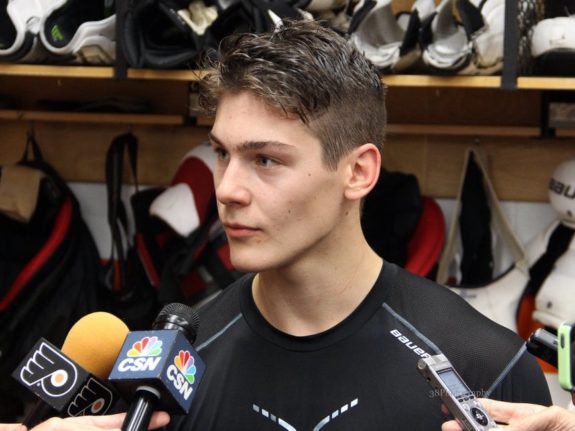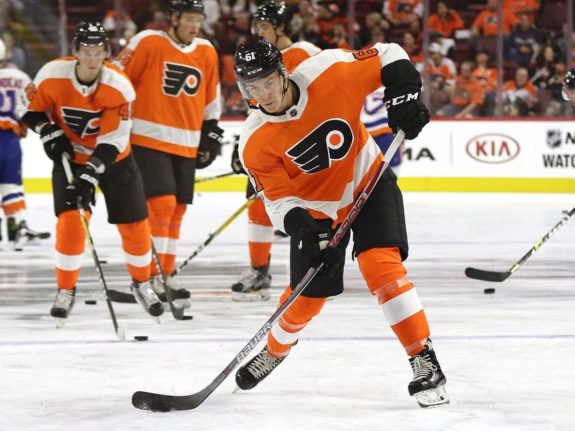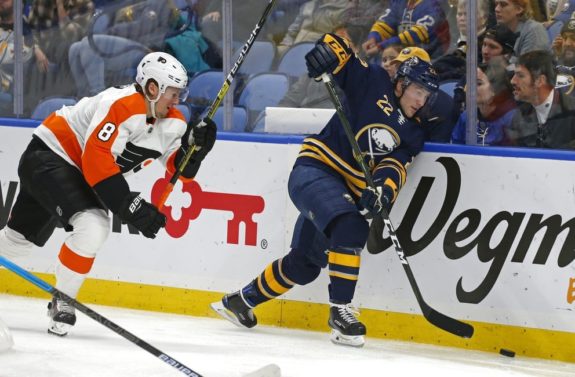A few seasons ago, the Philadelpia Flyers fan mantra was: “The defense may be a patchwork now, but in a few years, watch out!” Sometime in the future, they held, a deep arsenal of unique Flyers defensive prospects would vault the team back to relevance and contention.
Former general manager Ron Hextall and his predecessor (slash current team president) Paul Holmgren brought in half of the much-hyped bunch. Holmgren selected Shayne Gostisbehere in the third round of the 2012 NHL Entry Draft before grabbing Sam Morin and Robert Hagg in the first two rounds of 2013. Hextall added Travis Sanheim and Ivan Provorov with his opening picks in 2014 and 2015 before inking the tall, speedy, and somehow-undrafted Philippe Myers to a deal later in 2015.
All six were either believed to have NHL potential when acquired or demonstrated it shortly thereafter. Four of them are already NHL regulars. The two biggest, and most intriguing, are the two that are not.
Samuel Morin’s Rough Road
The 6’7” Morin was a fascinating selection: Simultaneously huge and able to skate, he was a mean-but-capable defender with a monstrous reach who seemed destined to fill the void left when Chris Pronger’s career ended the previous season.
In his full seasons with the Lehigh Valley Phantoms (2015-16 and 2016-17), he was essentially as-advertised: Steady, intimidating, and mostly content to keep his game simple. He amassed 7 goals and 28 assists in those 150 games but tacked on over 100 penalty minutes in both campaigns.

Injuries have derailed his progression, though: he was held to just 15 games in the AHL and two in the NHL last season before an ACL tear in the AHL playoffs knocked him out until at least next month. It’s unclear what that great skating stride will look like after such a devastating leg injury, having played so little hockey in the past two calendar years. He’s since returned to skating and says the leg feels good, but he recently declared that his lungs were “burning” after an on-ice workout.
The injury setbacks chewed through all of his entry-level contract but the team was able to re-sign him for three years at just $700,000 per this past summer. All season, he has sat on injured reserve for the big club to avoid waiver complications.
Philippe Myers and the Waiting Game
When one watches Philippe Myers play in Allentown, it’s hard to pick out any particular aspect that’s keeping him off an NHL roster. He’s been a two-way force, adding 45 points in 88 games over two seasons while playing smart defense and providing excellent breakouts. He might already be a better player than some seeing serious minutes on Broad Street this season.
Myers showed off his wares in the preseason and training camp and was the second-to-last defender cut from camp. According to NBC Sports Philadelphia, he impressed fellow speedsters like Gostisbehere and Travis Konecny with his skating and lateral movement.

Despite strong showings in his preseason appearances, his shot at the roster was doomed by one pivotal turnover in the third-to-last preseason game: Already down three goals against the Boston Bruins, Myers caught up with an attacking forward and stole the puck in his own corner…then promptly backhanded it blindly into the high slot for another Bruin to one-time it into the net. The next day, he was sent to the Phantoms to start the season there.
Ugly as that sequence was, it was an isolated event that he rarely repeats on AHL ice. The demotion happened under the previous Hakstol/Hextall regime, often criticized for its propensity to slow-cook promising prospects in favor of stopgap veterans.
What Morin and Myers Mean for the Flyers Defense
Fans are excited to see what Morin and Myers can bring to a young Flyers defense that has shown both flashes of brilliance and stretches of rattling inconsistency.
The most obvious thing that Myers and Morin would bring to a revamped Flyers blue line would be size: looming, unteachable size paired with skating ability. Provorov and Gostisbehere are good at what they do, but neither eclipse 6’0”. Sanheim is listed at 6’4”, but has never been a particularly physical player (though he may grow into that).
Infrequently-used-but-physical Christian Folin and the hit-happy duo of Radko Gudas and Robert Hagg are all smaller than the 6’5” Myers and 6’7” Morin and both of the untested prospects are significantly better skaters than those guys. What does that mean?
For one, they could be of use on the team’s woeful penalty kill, where corner battles, net-front clearing, and puck pressure have all been problems. Hagg and Gudas might be able to line up a player at the blue line, but they can’t provide the closing speed and lane interference that a fleet-footed 6’5” defender can. Myers might possess just enough edge to keep pace not only on the backcheck but also against shiftier forwards when defending against prolonged cycles.

Myers also uses his speed on the breakout, gladly lugging the puck from his own zone if he doesn’t spot an easy pass. He doesn’t attempt ridiculous spins like Gostisbehere but instead builds deceptive speed with his enormous strides to blow past passive forecheckers.
Morin, meanwhile, has the size and mean streak to do things the old fashioned way. Interim head coach Scott Gordon, who has ushered both prospects through their AHL careers, admitted that Morin would never be Pronger offensively, but that he has a bit of the old legend’s tenacity in his own end. That could be an enormous boost for a Flyers team that, in recent years, has lacked a certain snarl. Balancing net-front dominance with the increasingly tight calls on slashes and crosschecks could, however, be a learning curve for the big defender.
If Morin and Myers Stay, Who Goes?
If those two are injected, however, others must shake loose. The Folin and MacDonald experiments likely end as soon as their contracts do, so that leaves Sanheim, Provorov, Gostisbehere, Hagg, and Gudas on the table going forward.
Provorov and Sanheim are perhaps as close to untouchable as two young defensemen can be. Provorov’s been projected as a future Norris Trophy contender, an eternally smart player in the Drew Doughty mold. Sanheim has emerged from an up-and-down rookie season to look every bit the big, confident two-way player he was drafted to be.
Myers, with his vast toolkit (right-hand shot included), is a fit anywhere in the defensive lineup. If he develops to his ceiling, he could push the other two and perhaps turn out the best of the bunch.
If Morin shakes off the rust and recovery woes after leg surgery and returns to form, the Flyers would then possess three stay-at-home defensemen for two starting spots. With his ceiling, expectations, age, and bargain-basement salary, a healthy and capable Morin would be the ideal choice over either Gudas or Hagg. Neither can grow longer arms, and they’d probably be even less likely to take a pay cut when their contracts end in 2020.

That’s a couple of “ifs”, however. And another “if” is whether or not Chuck Fletcher (and the characteristically impatient Flyers brass) are looking for quick fixes and veteran contributors to have a more immediate impact. If that turns out to be the case, one could see Gostisbehere packing his bags alongside Gudas or Hagg: He’s an established brand with good value and, despite his very rare abilities, maybe the least essential. All that depends, however, on Fletcher’s vision and the two prospects’ development.
With the season all but lost, it’s increasingly likely that one or both of Philippe Myers and Samuel Morin get a look in NHL sweaters sooner rather than later. What the pair do then will be up to them, but the intrigue remains as thick as when they each joined the organization.
That dominant defensive arsenal, though, may still be a few years away.